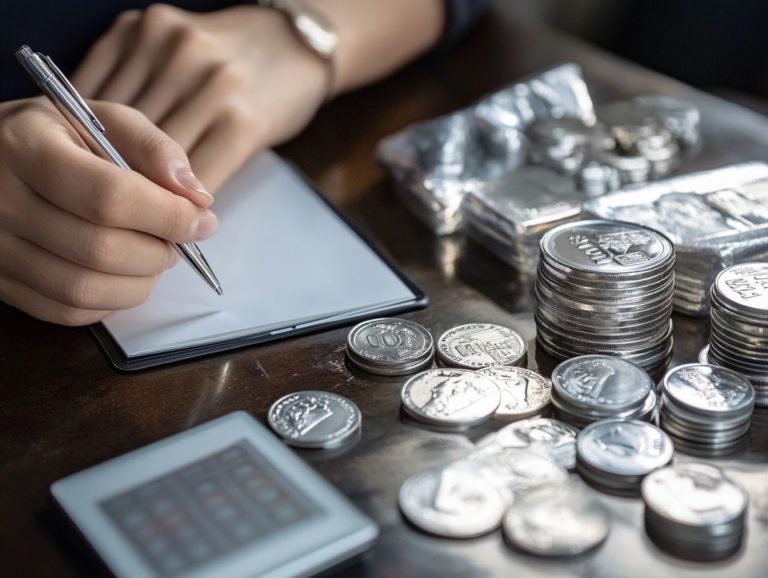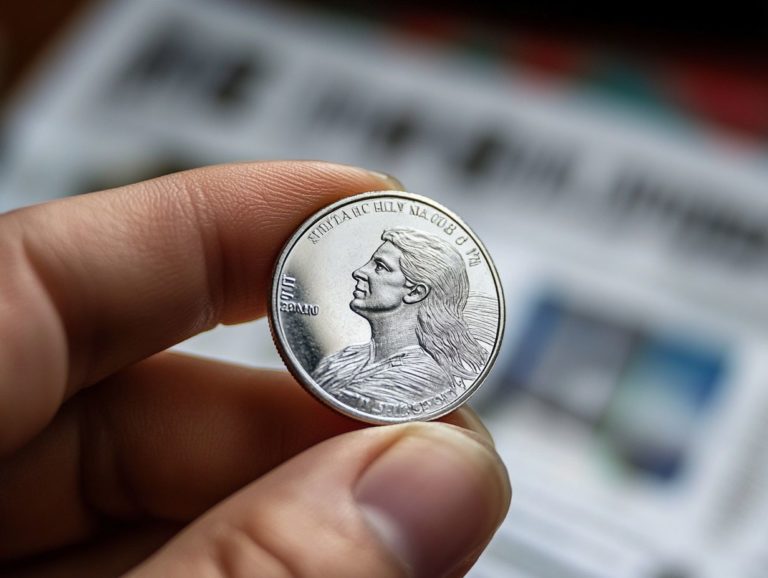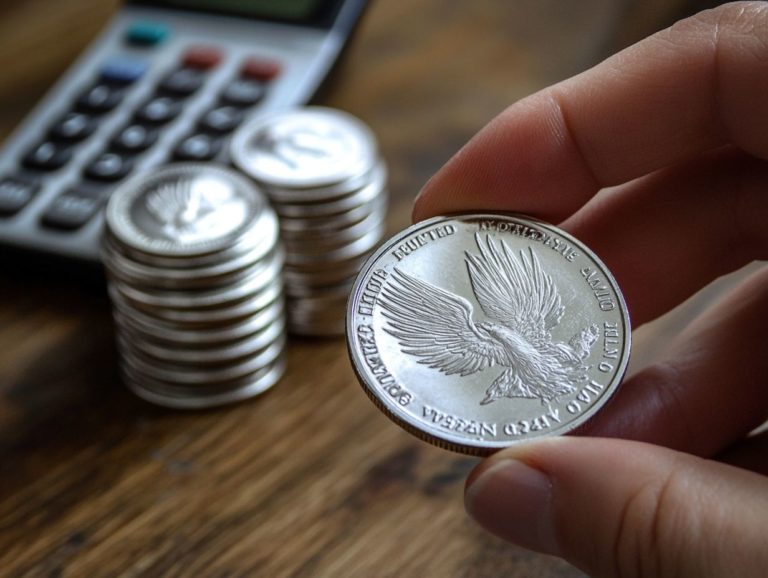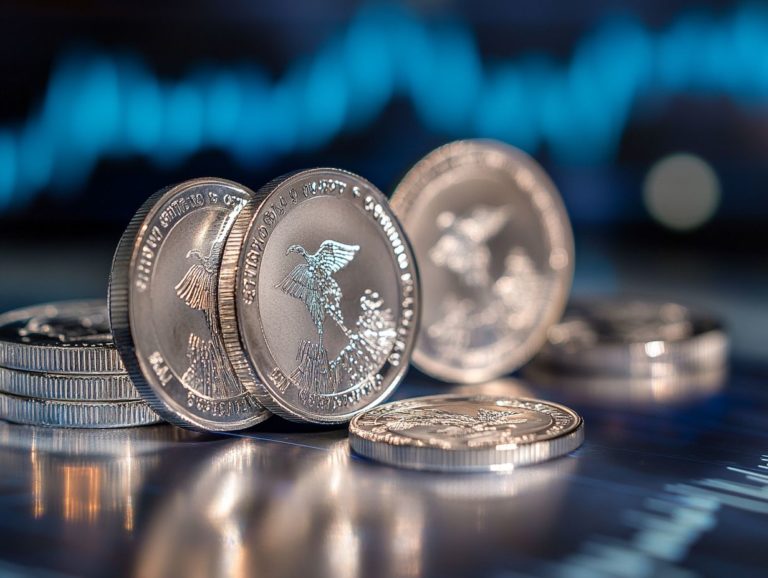Investing in Silver: A Beginner’s Guide
Silver investing presents a remarkable opportunity for you, whether you’re a seasoned investor or just starting in the world of finance.
With its potential for diversification and protection against inflation, silver can be an invaluable addition to your investment portfolio. This guide explores different types of silver investments, from physical silver to silver stocks, while emphasizing key factors to consider, like market trends and risk assessment.
You’ll find a roadmap for beginners eager to embark on their investment journey, along with effective strategies designed to maximize your returns. Whether you re curious or fully prepared to invest, this article has something tailored just for you.
Contents
- Key Takeaways:
- Benefits of Investing in Silver
- Types of Silver Investments
- Factors to Consider Before Investing in Silver
- How to Start Investing in Silver
- Maximizing Returns on Silver Investments
- Frequently Asked Questions
- What is the difference between investing in silver and investing in gold?
- What are the different ways to invest in silver?
- Thinking about investing in silver as a beginner? Here s what you need to know!
- What are the factors that can affect the price of silver?
- How can I determine the best time to invest in silver?
- Is there a risk of fraud when investing in silver?
Key Takeaways:
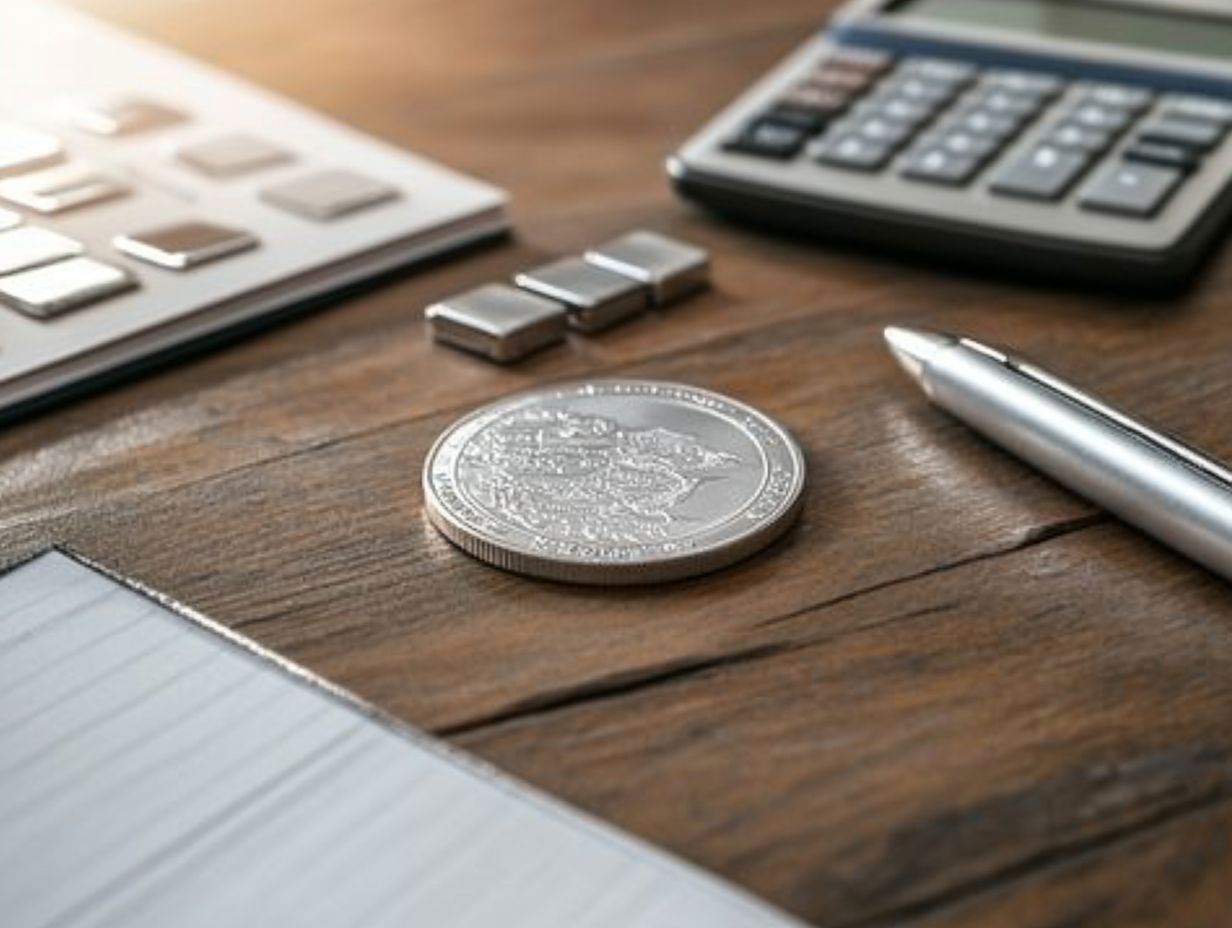
Silver investing offers diversification and protection against inflation, making it a valuable addition to any investment portfolio.
There are various types of silver investments, including physical silver and silver stocks, each with its pros and cons that should be carefully considered before investing.
Before investing in silver, assess market trends and evaluate risks by considering investing in precious metals: market insights to make informed decisions.
What is Silver Investing?
Investing in silver involves acquiring this precious metal as a financial asset, whether in the form of physical silver, silver bullion, or more sophisticated investment vehicles like silver futures and funds that trade on stock exchanges (ETFs) that hold silver. Many view silver as a safe-haven asset, especially during economic uncertainty, offering a hedge against inflation while providing an opportunity for portfolio diversification due to its liquidity and historical stability.
You can take several approaches to invest in silver. You can opt for tangible forms, such as coins and bars, or explore more complex strategies like silver futures contracts or ETFs like SLV and SivR. These funds allow you to gain exposure to silver without the hassles of storage or security issues related to physical assets.
Investing in silver not only acts as a buffer during inflationary periods but also enhances liquidity during market turbulence, making it an attractive choice for both seasoned and novice investors. With its unique blend of scarcity and industrial demand, silver can play a strategic role in building a balanced and resilient investment portfolio.
Benefits of Investing in Silver
Investing in silver offers a wealth of benefits that make it appealing for both seasoned and novice investors. It’s a smart way to diversify your investment portfolio, providing a robust shield against inflation while serving as a safe-haven asset during market fluctuations.
The market price of silver tends to move inversely to traditional equities and bonds, positioning silver as a strategic enhancement to your investment strategy.
Diversification and Inflation Protection
Portfolio diversification serves as a cornerstone of your investment strategy, helping to mitigate risk by spreading investments across various financial instruments, asset classes, and markets. In this context, silver emerges as a vital component. As a precious metal, silver acts as a hedge against inflation, preserving your purchasing power when traditional currencies may struggle, thus contributing to overall market price stability.
The unique characteristics of silver, particularly its low correlation with stocks and bonds, make it an invaluable tool for those seeking stability in their investments. For example, during the inflationary period of the 1970s, when inflation soared to around 13%, silver prices surged from approximately $2 to over $40 per ounce. This robust performance provided a buffer against stock market volatility and offered a tangible asset during economic uncertainty.
Statistical analysis consistently shows that silver often retains its value even as equities decline, reducing overall portfolio risk and enhancing potential returns during turbulent times. Including silver in your investment strategy can lead to a more resilient and well-rounded portfolio.
Start your silver investment journey today and secure your financial future!
Types of Silver Investments

You have a variety of options when it comes to investing in silver, each designed to suit different investment preferences and risk tolerances. Consider physical silver, such as bullion or American Eagle coins, for a tangible asset.
If you’re inclined toward derivatives, which are financial contracts whose value depends on the price of silver, silver futures might catch your interest. Alternatively, you could explore exchange-traded funds (ETFs) that own silver or delve into silver mining stocks, like the Global X Silver Miners ETF.
Each of these investment types comes with its own unique set of risks and benefits, giving you the power to craft a tailored approach to silver investing that aligns with your financial goals.
Physical Silver vs. Silver Stocks
When considering silver investments, you face a choice between physical silver and silver stocks. Each represents a unique investment strategy with its own mix of risk and reward.
Physical silver think bullion and coins offers you tangible ownership and acts as a hedge against economic instability. On the other hand, silver stocks, including those of silver mining companies, give you exposure to the market price fluctuations of silver and the potential for capital growth, which is the increase in the value of your investment.
You ll often find yourself weighing the liquidity of these options. Selling physical silver can be a bit of a hassle, requiring time and effort. You can also quickly trade silver stocks on exchanges at your convenience.
However, owning physical assets does come with its own responsibilities, such as storage costs and security measures, unlike the more straightforward management of stocks.
Looking at historical performance, you’ll see that physical silver frequently retains its value during market downturns. In contrast, silver stocks can be quite volatile, influenced by company-specific factors. For those buying physical silver, successful strategies often involve timing purchases during market dips. Meanwhile, stock investors may benefit from diversifying within the mining sector to mitigate risks.
Factors to Consider Before Investing in Silver
Don’t miss out! Assess these key factors before investing in silver, including market trends, the inherent risks related to price volatility, and the liquidity of your silver assets.
Understanding these elements helps you see how silver fits into your investment strategy. It also shows its potential as a hedge against inflation.
Informed financial decisions hinge on this thorough evaluation, giving you the power to navigate the silver market with confidence.
Market Trends and Risk Assessment
Market trends are pivotal in shaping your investment strategies in silver. Fluctuations in demand, geopolitical tensions, and inflation rates can significantly influence silver’s value.
By conducting a thorough risk assessment, you can determine the optimal moments to enter or exit the silver market, maximizing your returns.
Understanding the historical context of these trends is equally vital. For instance, during events like the 2008 financial crisis, silver prices surged as investors flocked to safe havens.
Similarly, shifts in central bank policies such as interest rate adjustments or quantitative easing can either strengthen or undermine investor confidence in precious metals.
A closer look at supply dynamics, including how much silver is produced and recycled, reveals how these factors interplay with global economic conditions.
By utilizing data from reputable sources like the World Silver Survey and keeping an eye on geopolitical events, you can better anticipate market movements and make well-informed investment decisions.
How to Start Investing in Silver
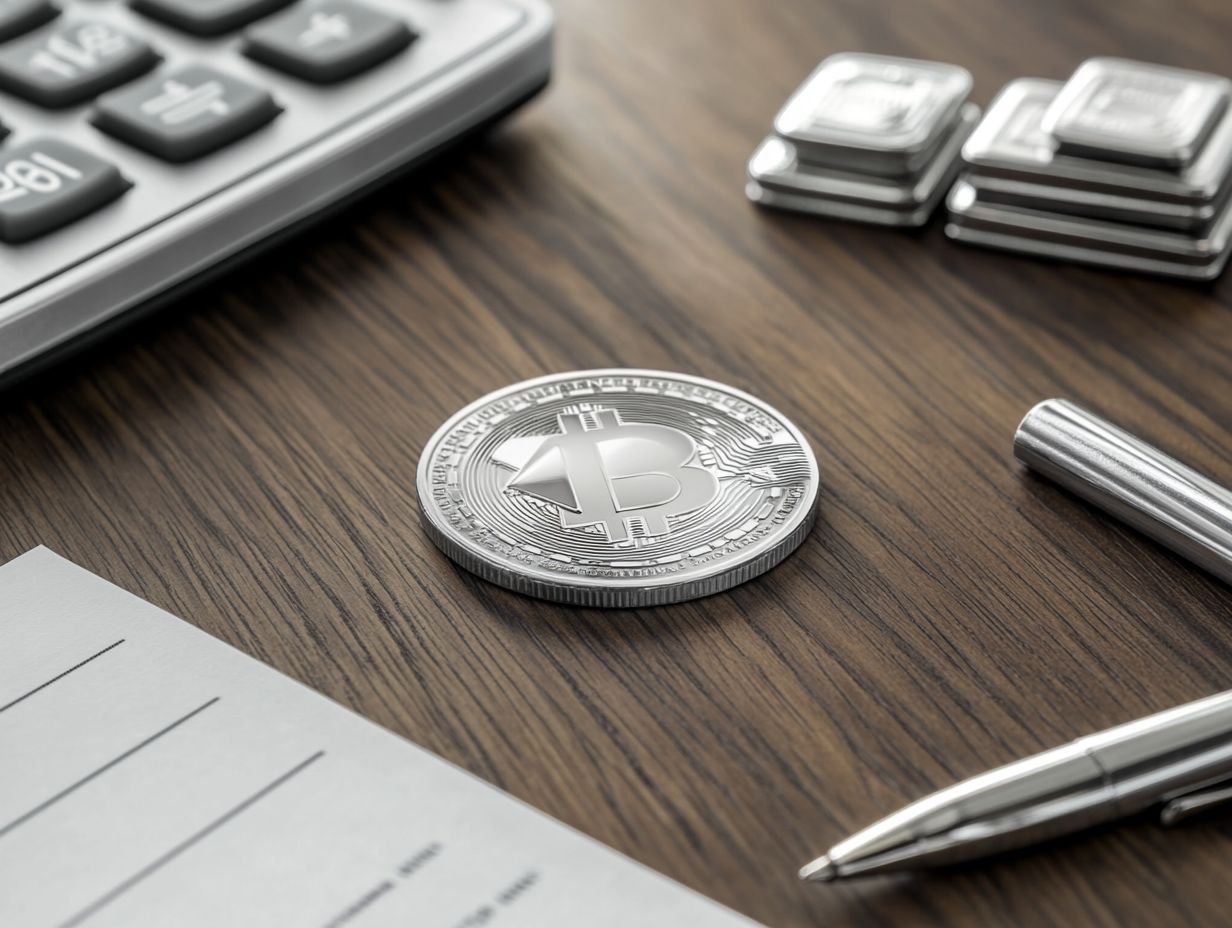
Investing in silver is a journey that begins with a clear understanding of the various avenues at your disposal. You’ll want to take decisive steps to allocate your resources wisely, whether you’re considering physical silver, silver bullion, or ETFs that hold silver.
As a newcomer, it’s crucial for you to evaluate your investment strategies thoughtfully. Establish clear goals and assess your risk appetite before diving into the silver market.
Start your silver investment journey today and secure your financial future!
Steps for Beginners
To start your silver investing journey, follow a structured approach. This includes researching various silver investments, setting a budget, and finding reliable platforms or dealers for buying physical silver or Exchange-Traded Funds (ETFs).
This foundational strategy ensures you begin with a solid understanding and prepares you for effective investment maneuvers.
Once you grasp the essentials, determine how much you re willing to invest based on your financial situation. This allows for flexibility within your portfolio.
Your choice between tangible silver like coins or bars and exchange-traded funds (ETFs) will hinge on your goals, risk tolerance, and desired liquidity.
The importance of sourcing silver from reputable dealers cannot be overstated. This choice significantly impacts both the quality and value of your investment.
Setting up an account with a trusted brokerage is a vital step, giving you the power to navigate this market effectively.
Monitoring your investments over time will help you stay informed and ready to adapt your strategies whenever necessary.
Maximizing Returns on Silver Investments
Maximizing returns on your silver investments involves a multifaceted approach. This demands meticulous planning, thorough market analysis, and the execution of astute investment strategies.
By grasping market price movements and exploring a range of options, such as silver mining stocks and ETFs, you can elevate your potential for substantial returns while effectively managing associated risks.
Strategies for Success
Implementing effective investment strategies is essential for achieving success in silver investing. These approaches enable you to navigate market price fluctuations and optimize your returns.
This includes evaluating opportunities in silver mining stocks, utilizing technical analysis, and staying well-informed about global silver demand trends.
Adopting a diversified approach by incorporating various forms of silver, such as coins and ETFs, can significantly mitigate risks while enhancing your potential for profit.
Diving deep into market research is key to unlocking your investment potential. Understanding factors influencing silver pricing such as geopolitical events and industrial usage will give you an edge.
By grasping these dynamics, you can leverage market trends more effectively. This allows for strategic entry and exit points that may lead to improved investment outcomes.
Ultimately, a well-rounded strategy that blends qualitative insights with quantitative analysis can greatly contribute to your success in the silver market.
Frequently Asked Questions
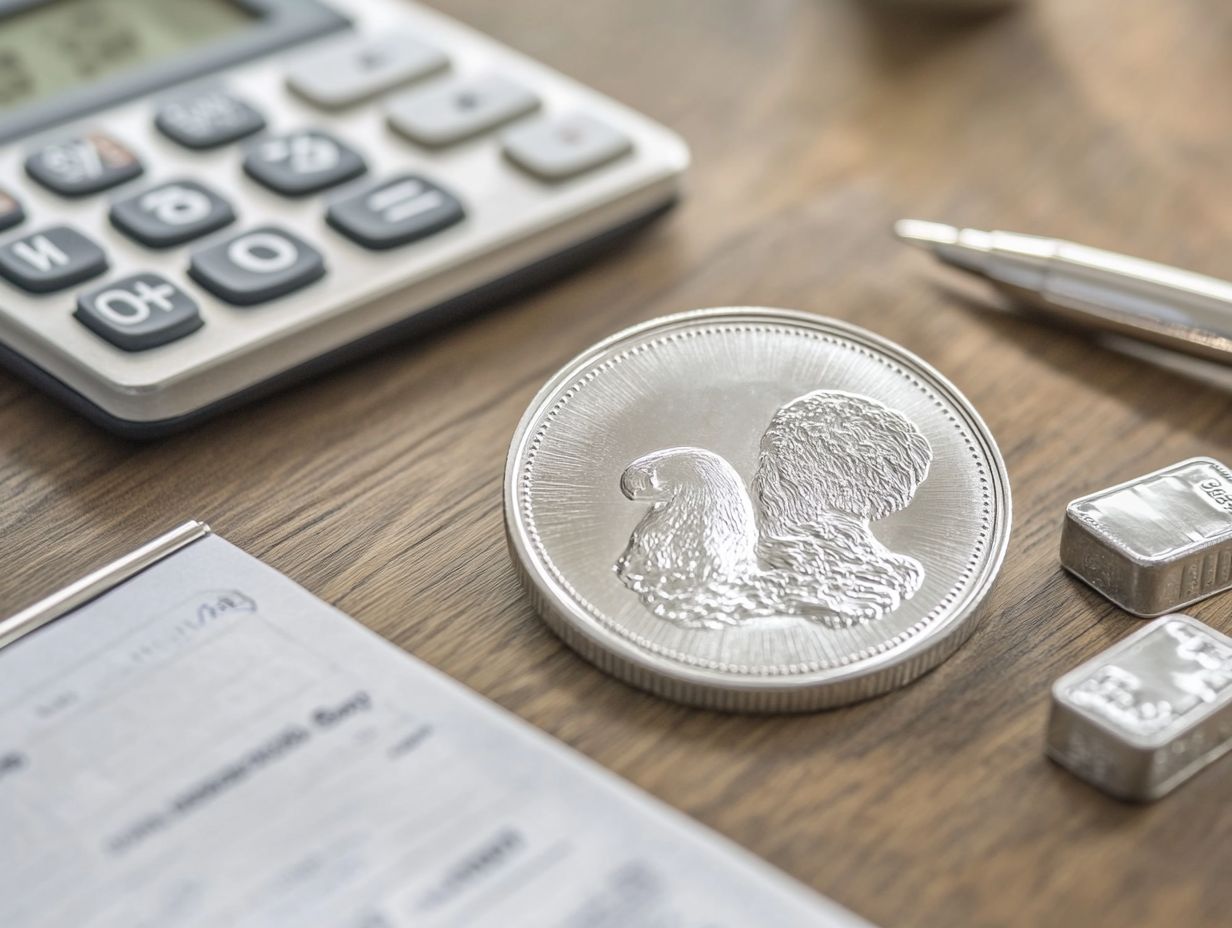
What is the difference between investing in silver and investing in gold?
Both silver and gold are considered precious metals for investment purposes. However, silver is typically more affordable, and its price tends to be more volatile compared to gold. Silver also has industrial and technological uses, while gold is primarily used for jewelry and as a store of value.
What are the different ways to invest in silver?
There are several ways to invest in silver. This includes buying physical silver such as coins or bars, investing in silver exchange-traded funds (ETFs), purchasing shares of silver mining companies, or trading silver futures contracts. Each method has its own advantages and risks. It’s important to do thorough research before deciding which option is best for you.
Thinking about investing in silver as a beginner? Here s what you need to know!
Silver can be a good investment for beginners because it is more affordable and easier to acquire compared to other precious metals like gold. However, like any investment, it comes with risks. It’s important to educate yourself on the market and make informed decisions.
What are the factors that can affect the price of silver?
The price of silver can be affected by various factors such as supply and demand, economic conditions, inflation, and geopolitical events. For example, if there is an increase in demand for silver in industrial applications, its price may go up. Similarly, if there is a decrease in supply due to a decrease in mining production, the price may increase.
How can I determine the best time to invest in silver?
The price of silver can change rapidly. It’s crucial to do thorough research and talk to a financial advisor before investing.
Buy silver when prices are low and aim to sell when they are high for potential profit. However, predicting market movements is tricky.
Focus on a long-term investment strategy rather than just short-term gains.
Is there a risk of fraud when investing in silver?
Yes, investing in silver carries a risk of fraud, just like any investment.
Always research and purchase from trusted dealers. Inspect any silver you buy to confirm its authenticity.
If you invest through a third party, ensure they are reputable and regulated.












